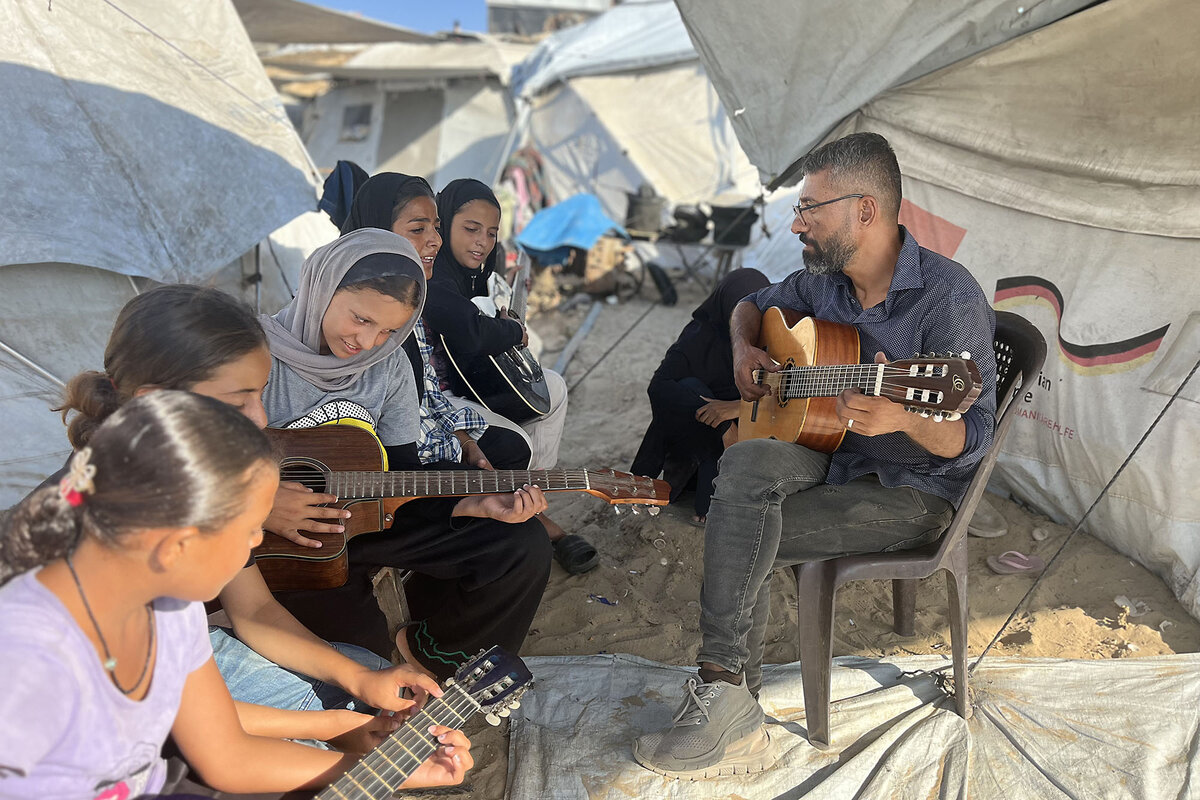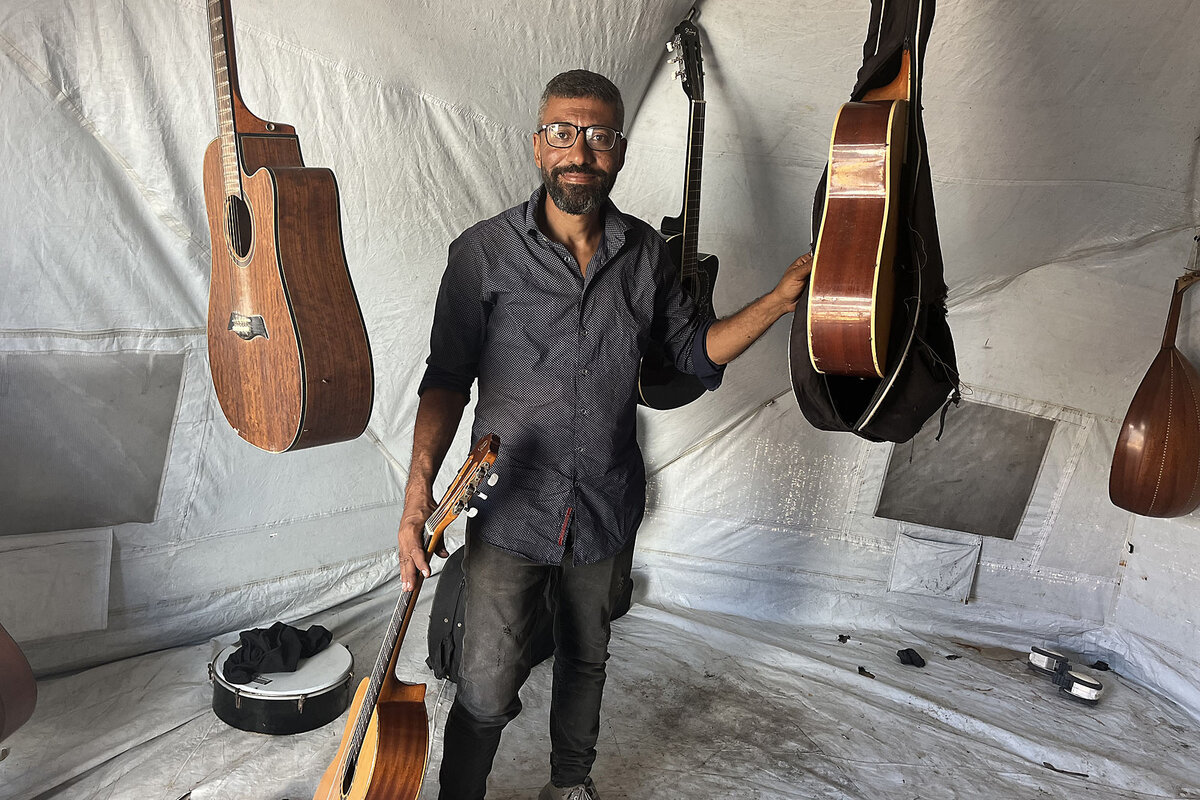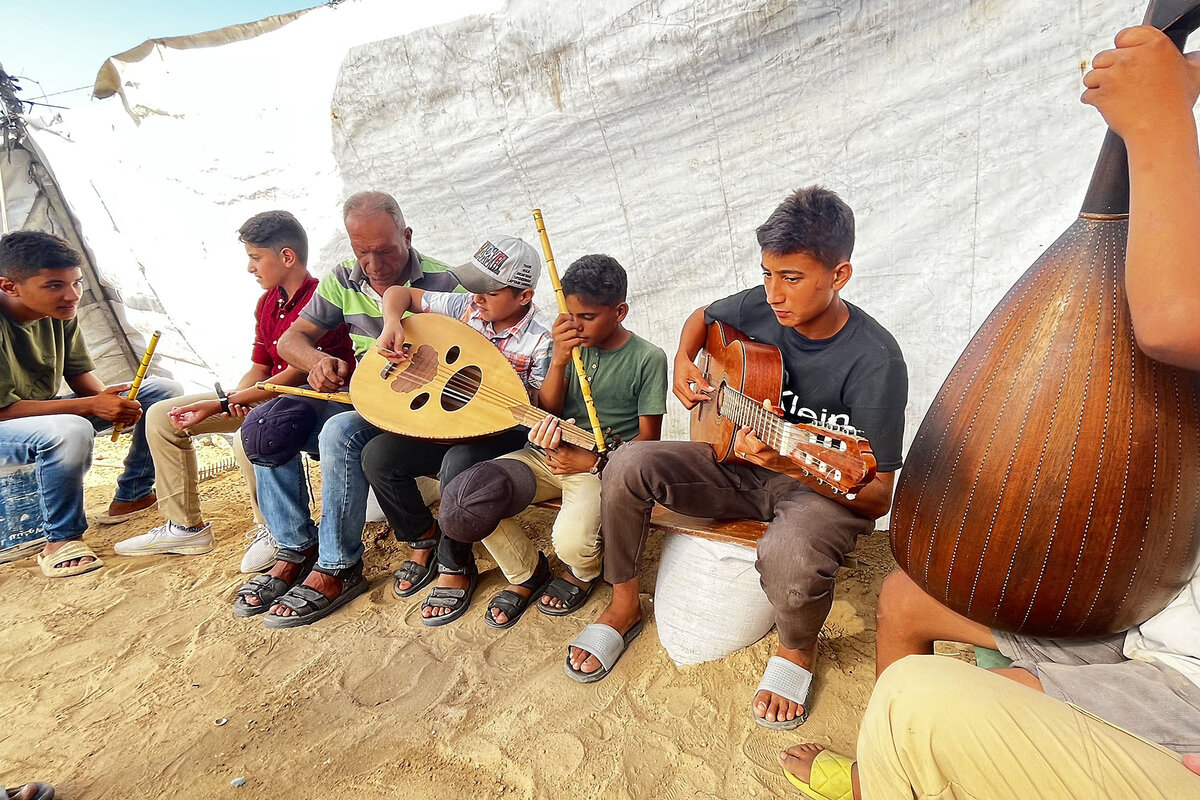In Gaza, a music teacher sings above the din of war
Loading...
| Deir Al Balah, Gaza Strip
One day in August, Gazan music teacher Ahmed Abu Amsha picked up his phone, faced the camera, and .
“Today there’s a lot of drones,” he explained from inside a tent in Gaza City.
With a group of his teenage students gathered behind him, the 40-something teacher began to hum, harmonizing with the low, monotone pitch of the machines hovering above. Then he broke into song. The students drifted in behind him, the layers of their voices rising hauntingly above the mechanical buzz.
Why We Wrote This
In Gaza, war is a constant soundtrack. Music teacher Ahmed Abu Amsha teaches his students to sing above it.
On Instagram, the video went viral – a call-and-response with a duet partner no one would ever choose. It became a symbol of Gazans’ determination to pluck beauty from the horrors of life under Israeli siege. “We will not cancel the music,” Mr. Abu Amsha remembers telling his students then. “We will sing with the drone – over it, not under it.”
Three months later, a ceasefire in Gaza has largely silenced the crash of airstrikes here. But drones still fly low over Mr. Abu Amsha’s tent, the soundtrack of an occupation that hasn’t ended.
“I cannot feel [the ceasefire],” he says. “The war is still here on the ground.”
Gaza Birds Singing
Mr. Abu Amsha had been teaching music for nearly two decades when Israeli retaliation for Hamas’ Oct. 7 attack forced him from his home in Beit Hanoun, in northern Gaza, in October 2023. His family fled south, first to Rafah, and from there to Khan Younis, where they settled in a makeshift tent camp hugging the sea, known as Al Mawasi.
Immediately, Mr. Abu Amsha approached the camp’s informal leaders, introducing himself as a music teacher. The reply was blunt. “Music! Ahmed! We do not want music,” he remembers being told. “We need food, we need water, we need tents.”
But he was determined, and began circulating an offer of free music lessons to parents across the camp. At first, they were wary. But then reports trickled back from the first students: A boy with severe insomnia slept through the night; a girl who had gone quiet began to speak again.
“Parents started thanking me,” he recalls.
Mr. Abu Amsha called his project . To keep up with demand, he scavenged for anything he could find that made a musical sound. He followed carts hauling rubble and picked through them in search of broken instruments, repairing whatever he could find. When salvage ran out, he took wires from broken bikes and turned them into strings for a guitar. He drilled holes into plastic pipes and transformed them into flutes.
As Mr. Abu Amsha and his students made melodies from the detritus of war, he was also using music to tell stories of the losses vibrating through Gaza.
One day, he came across a neighbor sitting wordlessly beside a half-built tent. Did he want help? Mr. Abu Amsha asked. The man refused. The next day, Mr. Abu Amsha returned, and the next. But the man would not accept. Later, he learned why: All eight of the man’s children had been killed.
From the encounter came a poem, “I Have No Address,” which fed a melody – , part letter to an abstract future.
He tells me his story with determination in his eyes…
Children sleep beneath the rubble
But we are not afraid of your bombs.
The sun will rise and the darkness will fade.
Free Palestine.
Another song grew from Mr. Abu Amsha’s return to his home in Beit Hanoun in January 2025, during the first ceasefire between Hamas and Israel. Leveled by Israeli bombs, the familiar city disoriented him. Streets mapped to memory no longer existed.
I had a neighbor,
Walking strangely,
He did not know where to find his home,
Although it was close.
By March, Mr. Abu Amsha and his family had finally managed to clear the rubble from their home, setting up a small corner for music lessons, when Israel broke the ceasefire. They fled again, this time to Gaza City.
A traveling band
There, drones hovered overhead day and night.
“They are like mechanical insects,” Mr. Abu Amsha says. During music lessons, his students began to complain. Some suggested they just cancel their sessions altogether. No, Mr. Abu Amsha told them, when the drone’s pitch wavers, your voices must be steady. If the sound gets louder, lift your voices higher.
As in Al Mawasi, the music lessons brought comfort. Children who had stopped speaking found their voices in a chorus. A boy displaced multiple times learned to keep time on a drum made from salvaged plastic.
Mr. Abu Amsha’s eldest son, Mu’in, soon joined the project, learning to tune by ear and change the strings of an oud, a traditional Middle Eastern stringed instrument with a short neck and pear-shaped body, known for its warm, resonant tones. The family’s running inventory included five guitars, three ouds, four tabla drums, and three violins – some pieced together from shards, others donated.
When Israel ordered residents of Gaza City to leave again in August, Mr. Abu Amsha and his family ferried these instruments with them. In Az Zawayda in central Gaza, the music lessons began again.
After a new ceasefire began in mid-October, some of his students began to return to the remains of their homes in Gaza City. But Mr. Abu Amsha’s house in Beit Hanoun lay within the half of Gazan territory still occupied by the Israeli military.
Homesickness thrummed through him.
“It’s there that my father taught me music, where I built my first studio, where I sang for the first time,” he says. “That is the origin.”
Meanwhile, for many of Mr. Abu Amsha’s students, he was the origin, the source of their love for music.
On a recent Saturday afternoon, about 50 students gathered in his tent. Some had never seen a musical instrument before. One awestruck girl kept reaching out to touch Mr. Abu Amsha’s guitar.
He split them into groups. Some of the students worked on percussion, tapping out rhythms while sitting on overturned jerrycans. Another group watched attentively as he introduced them to the guitar. In the third station, another teacher, Osama Jahjouh, or Abu Awni, led a flute lesson.
Forty minutes later, Mr. Abu Amsha gathered the students back together in a circle and started to teach them a simple song.
There was a young boy
Playing in the neighborhood,
Searching for string to fly his kite.
He looked up at the sky and wondered
What was shining there so bright.“Look, look! A kite is coming to me!”
But it was no kite at all.
It was a great airplane,
flying free without any string.








